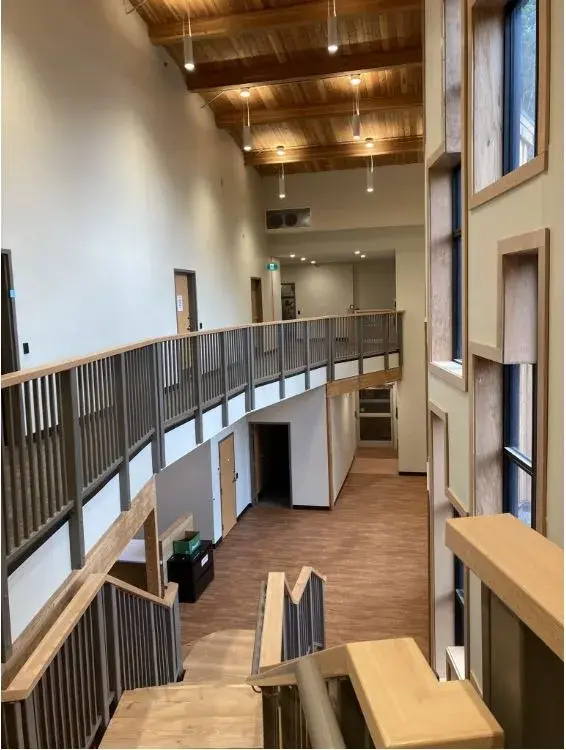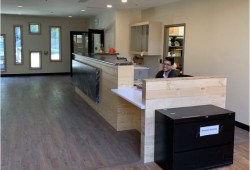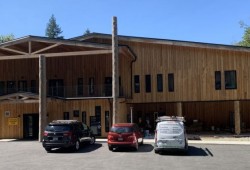Tsow-Tun Le Lum Society has opened its brand-new treatment centre in Cowichan Tribes territory. A ribbon-cutting ceremony was held at the bigger, new facility on Nov. 27.
Tsow-Tun Le Lum, which means Helping House in the Hul’q’umi’num’ language, is a fully accredited, registered, non-profit treatment society offering holistic and cultural supports for people, not only in addictions, but also for survivors of trauma. Tsow-Tun Le Lum has been helping Indigenous individuals break free from addictions and heal from trauma since 1988, starting at their facility in Nanoose.
It offers a 40-day substance misuse program, a five-week second-stage trauma recovery program and a 30-day grief program. The programs are steeped on Indigenous culture and teachings.
MLA Jennifer Whiteside, minister of Mental Health and Addictions, pointed out that the toxic drug crisis is impacting First Nations people at a rate much higher than the rest of the population. First Nations, she said, make up about four per cent of the population in the province, but they make up 17.7 per cent of B.C.’s toxic drug deaths.
“We know we have to work together to turn back the dial on this crisis,” she said.
“First Nations people continue to be disproportionately affected by the toxic drug poisoning crisis,” said FNHA board of directors’ chair, Colleen Erickson. “The ongoing legacy of colonialism, racism, discrimination, and intergenerational trauma leads many First Nations people experiencing addiction to avoid seeking treatment. The new Tsow-Tun Le Lum Healing House, and initiatives like it across B.C., will save lives by creating welcoming, safe spaces that are trauma-informed, restore connections to First Nations cultural and healing practices, and promote holistic healing.”
The Nanoose property occupied five acres of land, leased from the Nanoose First Nation. There was room in the facility for 32 client beds. Its last group of cohorts completed programs in November 2022.
The new building offers 20 treatment beds and living units for those who have experienced addiction, trauma, or grief. There is space for gender-fluid people. Inside the new building will be a place called the Spiritual Room.
According to Nola Jeffrey, executive director of Tsow-Tun Le Lum Society, there will be a living space for resident elders that go there to work with clients. In addition, it has a sweat lodge, pond, walking trails, a Big House, and private counselling spaces.
“Tsow-Tun Le Lum is a safe place where people learn new coping skills and feel good about who they are, let their light shine,” she said, in a previous interview with Ha-Shilth-Sa. “We use western methodology but most importantly, we use culture.”
The new building, located at 2850 Miller Road in Duncan, came in at a cost of $18 million.
“The First Nations Health Authority acknowledges the support of our provincial and federal government partners in supporting strength-based approaches to treatment programs and embedding First Nations’ traditional healing practices,” said Richard Jock, chief executive officer for the First Nations Health Authority. “Change requires system-wide, transformative approaches and Tsow-Tun Le Lum is a model for organizations seeking to provide culturally safe and trauma-informed cultural, emotional, addictions and healing services to First nations people.”
“Everything we do at Tsow-Tun Le Lum is guided by our ancestors and all the cultural teachings and ceremonies that have been passed down to us today,” said Daniella David, board chair, Tsow-Tun Le Lum Society. “Our programs are designed to bring out the goodness in people who have been hurt and lost confidence in themselves. We’re here to help rebuild their sense of self-worth and that means connecting to culture and to the land, where healing can happen holistically.”
“This place will save so many lives,” said Whiteside.
Tsow-Tun Le Lum Healing House should see its first clients in early 2024. Due to confidentiality and privacy concerns, program dates are not publicized.



